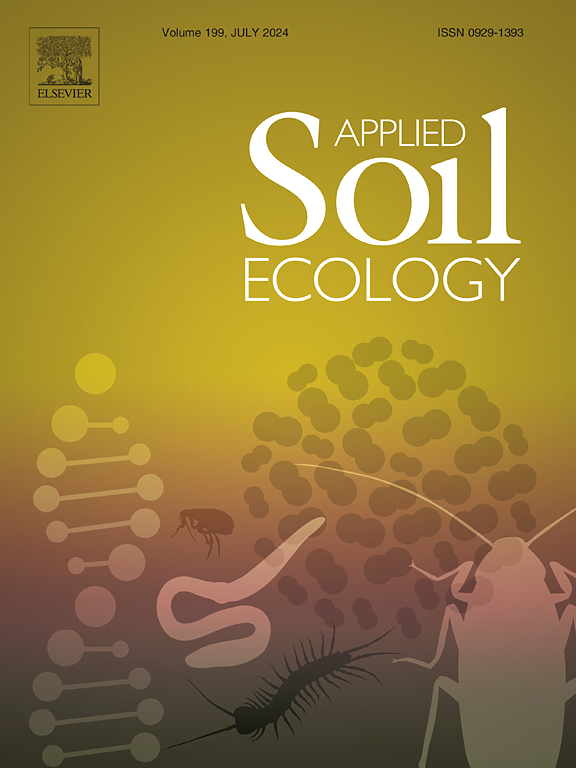Litter, root, and mycorrhiza manipulations and seasonal effects on soil physicochemical properties and microbial communities in a subtropical coniferous and broad-leaved mixed forest
IF 4.8
2区 农林科学
Q1 SOIL SCIENCE
引用次数: 0
Abstract
Organic inputs from aboveground litter and underground roots are an important factor affecting nutrient cycling in forest ecosystems. However, we still know little about the seasonal effects of the interaction between aboveground and underground organic inputs on soil organic carbon, nutrients and microorganisms after vegetation restoration in degraded red soil. Therefore, we focused on a mixed forest dominated by Schima superba and Pinus massoniana that had been restored for 27 years on eroded and degraded red soil in a subtropical region. Five treatments were set as follows: retaining aboveground litter + retaining root + retaining mycorrhizae (LRM, control treatment), doubling aboveground litter + retaining root + retaining mycorrhizae (DLRM), removing aboveground litter + retaining root + retaining mycorrhizae (NRM), removing aboveground litter + removing root + retaining mycorrhizae (NNM), and removing aboveground litter + removing root + removing mycorrhizae (NNN). After more than three years of treatment, DLRM, NRM, NNM, and NNN treatments reduced soil moisture content by 32.0–56.8 % in the rainy season compared with the LRM treatment. Soil total nitrogen and ammonium nitrogen concentrations were the highest in the DLRM treatment. Soil ammonium concentration and pH were higher in the rainy season than those in the dry season, while soil nitrate concentration was higher in the dry season. Soil available phosphorus concentration in the dry season decreased by 64.5 % in the DLRM treatment, while they were 2.0–10.7 times of those in the LRM, NRM, NNM, and NNN treatments compared to the rainy season. Soil microbial communities were dominated by bacteria across treatments, accounting for 74.0–75.5 % of the total phospholipid fatty acid (PLFA) of soil microbes, and there was no significant difference among treatments. Except for fungi, the total PLFAs of soil microorganisms and the PLFA content of each microbial taxon were higher in the dry season than those in the rainy season. The F/B value in the rainy season was higher than that in the dry season. The PLFA contents of gram-positive bacteria and actinomyces in the DLRM and NRM treatments were higher than those in the NNM treatment, and PLFA contents of both in the dry season were 1.5 and 1.6 times of those in the rainy season, respectively. Soil total phosphorus and pH had the highest contribution to soil microbial community changes in rainy and dry seasons, respectively. Comprehensive evaluation showed that double aboveground litter addition was more conducive to soil quality improvement. In conclusion, litter, roots and mycorrhiza manipulations affected the PLFA contents of soil microorganisms through the regulation of soil physicochemical properties, rather than the proportions of each microbial taxon in the total PLFAs, which was related to the season. The results can provide a theoretical basis for soil quality improvement as driven by soil microorganisms during the restoration of degraded red soil.
亚热带针叶和阔叶混交林中的腐殖质、根系和菌根操作及其对土壤理化性质和微生物群落的季节性影响
地上枯落物和地下根系的有机输入是影响森林生态系统养分循环的重要因素。然而,我们对退化红壤植被恢复后,地上有机物和地下有机物输入对土壤有机碳、养分和微生物的季节性交互影响仍然知之甚少。因此,我们重点研究了在亚热带地区被侵蚀和退化的红壤上,经过 27 年恢复的以超马尾松(Schima superba)和马松(Pinus massoniana)为主的混交林。共设置了以下五个处理:保留地上落叶+保留根系+保留菌根(LRM,对照处理)、加倍地上落叶+保留根系+保留菌根(DLRM)、清除地上落叶+保留根系+保留菌根(NRM)、清除地上落叶+清除根系+保留菌根(NNM)和清除地上落叶+清除根系+清除菌根(NNN)。经过三年多的处理,DLRM、NRM、NNM 和 NNN 处理与 LRM 处理相比,雨季土壤含水量降低了 32.0-56.8%。DLRM 处理的土壤全氮和铵态氮浓度最高。雨季土壤铵浓度和 pH 值高于旱季,而旱季土壤硝酸盐浓度较高。旱季土壤可利用磷浓度在 DLRM 处理中下降了 64.5%,而在 LRM、NRM、NNM 和 NNN 处理中则是雨季的 2.0-10.7 倍。各处理的土壤微生物群落均以细菌为主,占土壤微生物磷脂脂肪酸总量的 74.0-75.5%,且各处理间无显著差异。除真菌外,旱季土壤微生物磷脂脂肪酸总量和各微生物类群的磷脂脂肪酸含量均高于雨季。雨季的 F/B 值高于旱季。DLRM 和 NRM 处理中革兰氏阳性菌和放线菌的 PLFA 含量高于 NNM 处理,旱季两者的 PLFA 含量分别是雨季的 1.5 倍和 1.6 倍。雨季和旱季土壤全磷和 pH 值对土壤微生物群落变化的影响最大。综合评价结果表明,地面双层垃圾的添加更有利于土壤质量的改善。总之,丢弃物、根系和菌根的操作是通过调节土壤理化性质来影响土壤微生物的 PLFA 含量,而不是各微生物类群在总 PLFAs 中的比例,后者与季节有关。这些结果可以为退化红壤修复过程中由土壤微生物驱动的土壤质量改善提供理论依据。
本文章由计算机程序翻译,如有差异,请以英文原文为准。
求助全文
约1分钟内获得全文
求助全文
来源期刊

Applied Soil Ecology
农林科学-土壤科学
CiteScore
9.70
自引率
4.20%
发文量
363
审稿时长
5.3 months
期刊介绍:
Applied Soil Ecology addresses the role of soil organisms and their interactions in relation to: sustainability and productivity, nutrient cycling and other soil processes, the maintenance of soil functions, the impact of human activities on soil ecosystems and bio(techno)logical control of soil-inhabiting pests, diseases and weeds.
 求助内容:
求助内容: 应助结果提醒方式:
应助结果提醒方式:


